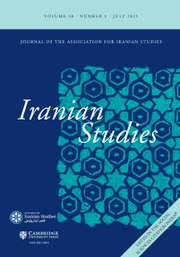Article contents
A Linguistic Survey of Khorasan: Implications for Language Isolation, Language Change, and Contact Linguistics
Published online by Cambridge University Press: 01 January 2022
Abstract
This paper describes and analyzes data from a number of Modern Iranian dialects spoken in Khorasan in the east of Iran which are unusual among the other Western Iranian languages in that they have grammaticalized a split tense-sensitive alignment in indexation, compared to other Iranian languages whose indexation splitness is sensitive to both tense and transitivity. These dialects are the former dialect of Birjand in the late nineteenth and early twentieth century, the present-day dialect of Ferdows, Khanik, and Se-Ghal’e. The findings are put in the context of the available data from the Classical Persian texts to show that the tense-sensitive splitness mentioned above is traceable in those texts. A number of external factors are discussed which seem to have been influential in the restructuring of the split-alignment of the former dialect of Birjand into a uniformly nominative-accusative alignment in terms of indexation as observed in the present-day dialect of Birjand. It is proposed that this restructuring is an instance of simplification. The three other dialects cited above are endangered in the sense that they can undergo the same kind of restructuring as happened to the dialect of Birjand.
Keywords
Information
- Type
- Language contact in Iranian Languages
- Information
- Iranian Studies , Volume 53 , Issue 3-4: Commemorating Ehsan Yarshater Endangered Iranian Languages: Language Contact and Language Islands in Iran , August 2020 , pp. 353 - 401
- Copyright
- Copyright © Association For Iranian Studies, Inc 2020
Footnotes
The symbols S, A, and P (also called O) stand for the subject of the intransitive verbs, the subject/agent of the transitive verbs, and the patient/object, respectively. Other abbreviations used in this paper are:
| 1: first person | DIR: direct | IO: indirect object | PRS: present |
| 2: second person | DO: direct object | IRR: irrealis | PST: past |
| 3: third person | EZ: ezafe (head-marking linker) | N: neuter | PTCP: participle |
| ABS: absolute | F: feminine | NOM: nominative | SBJV: subjunctive |
| ACC: accusative | GEN: genitive | OBL: oblique | SG: singular |
| AN: animate | INAN: inanimate | PERF: perfect | |
| COMPL: complete | INCOMPL: incomplete | PL: plural | |
| DEF: definite | INDF: indefinite | PREV: pre-verb |
The first version of this paper was presented as “Peculiar Alignments in Modern Iranian Languages” at the seventh International Conference on Iranian Linguistics held at Institute of Asian and African Studies, Lomonosov Moscow State University, 28—30 August 2017. The present completed and extended paper was presented at the International Symposium on Endangered Iranian Languages, 19-20 October 2018, Leibniz-zentrum Allgemeine Sprachwissenschaft, Berlin.
The journal’s reviewer provided extremely helpful and detailed comments on the manuscript and the paper has been modified according to those comments. Any remaining inaccuracies are the author’s responsibility.
References
- 1
- Cited by

